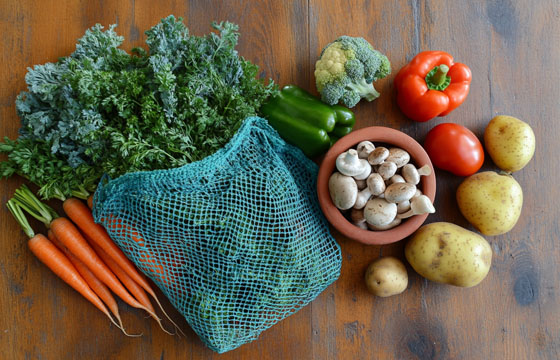A Month-by-Month Guide to Planting Vegetables in Your Garden

Timing is important in vegetable gardening. If you are not using an indoor garden system that works year-round, knowing when to start seeds and plant outside is key. Following a month-by-month guide can help you have a good harvest instead of a bad one. The USDA Plant Hardiness Zone Map divides North America into 13 zones. Each zone is 10 degrees warmer or cooler in winter than the one next to it. The best planting times depend on where you live. The timeline here is based on zone eight. To find the best times for your area, ask your local county cooperative extension for a calendar.
01 January
The more preparation you do now, the better your plants will do later.
If you're starting a new vegetable garden or improving an existing one, begin by drawing a map of your garden beds. Plan your arrangement for the upcoming season, keeping in mind that crops should rotate every year. It's helpful to keep and date these maps each year so you can track what was planted and when. You can also note successes and failures on the back of the maps to guide your planting decisions for the following year.
If you're starting plants from seed, check out catalogs and order early, as popular varieties may sell out. Look for terms like "new" and "improved," which often indicate real improvements in disease resistance, taste, and fruiting.
If you'd rather start with seedlings, make a shopping list for the nursery. Beginners should ask for advice on which vegetables are easiest to grow. Start small and expand as you gain more experience.
02 February
It is too early to plant most vegetables. There are tasks you can do inside and outside.
Finish your seed orders. When the seeds come, read the instructions on the packets. Make a chart with the dates to start each variety. Work backward from the last frost date in your area. Germination times are different, so start seeds at the right time. Write the planting date for each seed on a sticky note. Put it on the packet. Organize the seeds by planting date in a card file.
Get ready for seed starting. Buy enough growing mix, seed trays, and peat pots. It is also a good time to check outdoor planters.
Make sure you have the right tools for gardening. Check if anything is missing. Clean and sharpen your tools. You will need a round-headed shovel, a garden spade, a fork, a hoe, a dirt rake, pruning shears, a trowel, a garden thermometer, and a wheelbarrow. If your garden hose is worn out, replace it. Get gloves and garden shoes as well.
If the ground is workable, plant bare root perennial vegetables like asparagus, artichokes, horseradish, and rhubarb.
Start seeds for cool-season vegetables like broccoli, cabbage, kale, lettuce, spinach, and onions inside.
03 March
The weather this month can change. Be ready with row covers for frosts or freezes that can harm perennials.
Most vegetables like slightly acidic soil (pH 6.0 to 6.8). Use a pH test kit from a garden center to check your soil. If the pH is not right, follow the instructions to fix it. You can add organic matter to change the soil’s acidity. Even if the pH is good, improve the soil every year. Add compost, peat moss, or coir to help the texture. For perennial vegetables, add compost or aged manure. Spread it around the plants, mix it in, and rake it smooth. If the soil is bad, build raised beds and fill them with good soil.
Start seeds for warm-season crops like tomatoes, peppers, eggplant, pumpkin, snap beans, squash, and sweet corn.
Check the soil temperature with a garden thermometer. When it reaches 40°F, plant the seeds for cool-season crops like kale, lettuce, spinach, and onions.
At the end of the month, plant peas. If the ground is wet, wait before working in it.
04 April
The weather can change. Keep row covers ready for cold nights. Start planting now.
Check soil temperature with your thermometer. When it stays at 60°F or higher, you can plant warm-season crops.
If you didn’t start seeds, buy transplants or seedlings for early-season crops like radishes, spinach, onions, leeks, lettuce, cabbage, beets, peas, Brussels sprouts, and carrots.
Start planting early-season crops. Choose a cloudy day to reduce transplant shock. Water well when you plant. Add a two- to three-inch layer of mulch after planting to keep weeds down and moisture in.
For greens, plant seeds directly in the garden. Plant every few weeks for a steady harvest.
Keep seedlings moist until they grow roots. Remove weeds before they spread. Use natural weed killers in vegetable gardens.
05 May
Use warmer weather, longer days, and moist soil for most of your plantings. Don’t plant more than you can care for as the season moves on.
Check soil temperature. If it is over 70°F, plant heat-loving crops like tomatoes and peppers. Make sure you have the tools, like a watering can, to water the garden. As it gets hotter, you will need to water more.
Keep planting early-season crops. Also, plant tomatoes, squash, melons, eggplant, peppers, sweet corn, cucumbers, potatoes, and herbs. Water and mulch new plants carefully.
If you plant seeds in the garden, sow carrots, beets, and radishes. Don’t mulch until the seedlings are a few inches tall and thinned.
Follow seed packet directions for spacing. Thin seedlings as needed.
Look for insect damage on leaves, like missing pieces or broken stems. If you see damage, remove the affected leaves, cover the plants, or use an organic pesticide. Ask a garden center for advice.
Cool-season crops like asparagus, peas, and spring greens will be ready to harvest soon. The more you pick, the more they will grow.
06 June
Full speed ahead! Over the next few months, focus on maintenance and harvest.
Early this month, plant any remaining warm-season vegetables. Direct sow the warm-season crops in place. Keep thinning seedlings of crops you planted earlier.
As your plants grow, be ready with staking materials. You will need bamboo stakes of different heights to support your crops.
About a month after planting, add organic compost to the crops. If you didn’t use mulch, use a scuffle hoe to remove weeds.
Harvest when temperatures are lower, like in the early morning or evening. Continue to pick greens, peas, beans, and herbs. Stop picking asparagus and rhubarb so they can rebuild for next year.
07 July
You can't slack off completely, but get ready for the big payoff.
Extend the season with a late harvest of beans, carrots, cucumbers, cauliflower, and other cold-season crops. Where there is room, cultivate the soil and add compost before sowing seeds or planting seedlings.
Remove suckers—the growth between the main stem and the leaf—on tomato plants. Pull out any finished early-season crops. Keep staking tomatoes and other plants as needed.
Water in the early morning to reduce evaporation. Water the soil, not the leaves, to reduce fungal disease. Make sure to keep the soil moist so the fruit can grow well. Drought-stressed plants are more likely to have fungi and insect problems. Check the mulch and add more where it’s thin. Weed the garden because weeds take water and nutrients from plants.
Harvest daily. If there is too much produce, share it. Use an old plastic laundry basket to collect the ready produce, and rinse it off outside—it will act like a giant colander.
08 August
It's the dog days of summer, and both you and the garden need a break. Relax and enjoy.
Make some notes about your successes and failures. You might not remember those radishes or sickly tomatoes when you plan next year's garden.
If you haven't planted for the fall harvest yet, it's not too late to start now.
Monitor moisture, insects, and disease. If there's a problem, handle it right away. Pick up and throw away any fallen or rotting fruit—leaving it can cause diseases and attract insects.
Keep picking! Cut fresh herbs for freezing or drying to use in the winter.
09 September
With the weather getting less predictable, your priority is to protect tender plants like tomatoes from frost with sheets or covers to keep them ripening on the vine.
As temperatures lower, dig and prepare new beds for the spring or build raised beds and fill them with amended soil. Pot up your favorite, healthiest herbs in planters to bring inside for the winter. Continue planting cool-season vegetables for winter harvest.
Pull up finished plants and discard fallen or rotten fruit to stop insect larvae from surviving underground through the cold months. Make sure the mulch is thick enough on cold-season crops.
Some plants will keep producing through light frosts. Others will keep going only if protected overnight with covers. Green tomatoes can be picked, wrapped in newspaper, and stored in a cool spot (55-60°F) to ripen. If frost is expected and your tomato plants have unripe fruit, you can pull the whole plant up by the roots and hang it upside down in a protected place like a garage. The fruit will keep ripening on the vine. Remove any bad tomatoes.
10 October
Mother Nature will decide what you can do. If the weather is good, keep working. If winter weather comes, do what you can.
Plant cool-season crops like beets, cauliflower, kale, cabbage, Brussels sprouts, broccoli, chives, celery, onions, parsley, parsnips, peas, radishes, spinach, lettuce, turnips, and Swiss chard.
Use floating row covers to protect new seedlings and winter crops from bad weather. These covers are made of light polyester that floats on plants. Remove garden debris and rake leaves out of beds. Put the leaves in a compost pile. Compost anything that is not diseased or full of insects. Store garden tools and supplies in a dry place. Take down and store stakes and cages used for plants.
Dig up potatoes and store them in a dark place with low humidity. Pick winter squashes and pumpkins before a hard freeze. Keep picking fall crops like beets, cabbage, chard, and leeks.
11 November
If the weather is good, you may still garden. Doing more now makes things easier in the spring.
Order seed catalogs for January planning.
Water cool-season vegetables if it doesn't rain enough. Feed plants with water-soluble organic fertilizer like fish emulsion every two weeks.
Cut asparagus plants to the ground once the leaves turn yellow or brown. Spread a few inches of aged manure or organic compost on the bed.
Pick greens and other cool-season vegetables when they are ready.
12 December
If you have a winter garden, continue harvesting, weeding, and watering as needed. If not, take time to enjoy the holidays.
What are some of the easiest vegetables to grow for beginners?
Radishes, asparagus, leaf lettuce, garlic, onions, zucchini, tomatoes, and cucumbers are good vegetables for beginners. The first five can take some frost, so plant them early. Plant zucchini, tomatoes, and cucumbers after the last frost in spring. Harvest them before the first frost in fall.
Does the climate impact the best time to start a vegetable garden?
Yes, climate affects when you should start a vegetable garden because the growing season depends on your local climate. To know when to start, find out the first and last frost dates in your area. Also, check the hardiness of the vegetables you want to plant.






